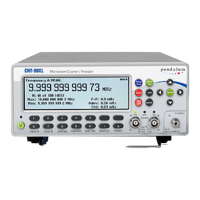8-50 Command Reference
In this way you can benefit from the automatic trigger level adjustment without sac
-
rificing measurement speed.
+
From the bus, input A and input B are always set to autotrigger individually.
Parameters:
<Boolean> = ( 1/ON | 0/OFF | ONCE)
Example for Input A (1)
SEND®
:INP:LEV:AUTO 8 OFF
Example for Input B (2)
SEND®
:INP2:LEV:AUTO 8 ON
Returned format: 1|0|ONCE¿
*RST condition: ON
:INPut«[1]|2» :LEVel :RELative
8 <Numeric value>
Relative Trigger Level
When autotrigger is active, the relative trigger levels are normally fixed at values
that depend on the selected function, for instance 10% (Inp A) and 90% (Inp B) for
Rise Time, 50% (Inp A & Inp B) for Time Interval, 70% (Inp A) and 30% (Inp B) for
Frequency. At times you may want to change these values. Since the default val
-
ues are restored automatically after changing function, this command may have to
be sent repeatedly. The two input channels are programmed separately and are
consequently not interdependent.
The command itself does not switch on autotrigger, so if you want to set relative
levels after having used abolute levels, you must also send the command
:INP:LEV:AUTO ON (see above), unless you have changed measurement func
-
tion.
Parameters
<Numeric value> is a positive number between 0 and 100 (%).
Example
SEND®
:INP:LEV:REL 8 20 (Inp A set to 20% to measure ECL rise time)
SEND®
:INP2:LEV:REL 8 80 (Inp B set to 80% to measure ECL rise time)
Returned format: <Numeric value>¿
*RST condition: Depending on function (see description above).

